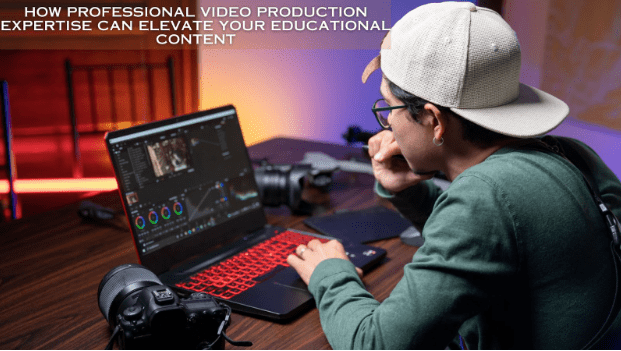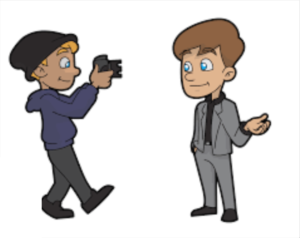The global eLearning market is projected to be worth over $325 billion by 2025. As online education experiences rapid growth, the importance of delivering high-quality and engaging video content becomes increasingly critical for educators and course creators. The investment in professional video production can transform lackluster educational materials into dynamic multimedia learning experiences, enhancing learner retention and comprehension.

The Impact of Production Quality on Viewer Engagement
In the rapid digital age, capturing and retaining viewer attention is an immense challenge with endless competing content a click away. For educational videos aiming to effectively impart learning, production quality correlates directly to engagement. MatchPoint Studio, located in Chicago, specializes in providing comprehensive video production services for businesses and organizations seeking high-quality content creation.
Although user-generated content (UGC) clips may initially pique curiosity, the presence of poor lighting, amateur camerawork, garbled audio, and disjointed editing quickly disrupts immersion in the learning process.
In contrast, professional video production incorporates broadcast journalism techniques to hook and hold attention. Cinematic lighting guides the viewer’s eye and establishes mood and tone. Steady tripod framing communicates competence and authority. Shotgun microphones capture crisp, unintrusive audio that doesn’t distract. Precise edits weave together individual shots into a cohesive cinematic flow moving the narrative forward.
Together these production elements enhance the perceived credibility of educational videos, reducing skeptical disengagement. Quality production, by mirroring the visual standards of multi-billion-dollar entertainment media, subconsciously signals to audiences that the content merits their focused attention.
Research by media psychologists indicates that higher production quality keeps viewers engaged and learning for longer periods by sustaining immersion and interest. For companies incorporating video into their learning and development programs, the impact of production polish is evident. Those with comprehensive video training experience a staggering 218% surge in yearly revenue per employee.
Storytelling Techniques for Memorable Learning
Professional video teams employ proven screenwriting techniques like hero’s journey story arcs to structure tutorials for maximum clarity and viewer payoff. Strategies like repetition, contrast, and foreshadowing are used to spotlight key takeaways. Motion graphics, music cues, and dynamic editing are crafted to mimic commercial entertainment, keeping attention hooked. Incorporating these best practices for visual storytelling and pedagogy results in content that educates more effectively.
Storytelling transforms educational videos from dry lectures to binge-able learning adventures. Instead of tuning out complexity, learners lean in.
Visual Effects and Animation
While live-action footage builds credibility through realism, skillfully executed visual effects and animation unlock unlimited possibilities for dynamically illustrating complex processes and ideas in education. From healthcare topics like anatomy and microbiology to engineering subjects like aerodynamics and quantum physics – the abstractions of these fields gain clarifying embodiments through thoughtful VFX and animation.
For example, detailed 3D animations can transport viewers inside the human body, allowing virtual flight through arteries and intricate details of physiological systems. Such novel vantage points would be impossible to show through standard video. Real-time motion tracking and green screens also enable presenters to interact with their own anatomical diagrams or molecular models for an immersive learning experience bridging physical and virtual.
Kinetically rich animated explanatory sequences excel in unpacking multifaceted ideas through a step-by-step visual feast. Acting as a guiding hand, animations actively reconfigure graphical elements across time, directing attention toward each narrative revelation. Integrating animated segments into curriculum videos brings dynamism and energy to otherwise static shots of lecturers, multi-sensory boosting processing and recall.
From physics simulations to historical recreations, the possibilities span as far as human imagination. Whether it’s animated infographics clarifying concepts or gamified choose-your-adventure interactions making abstract learning participatory – integrating professional VFX and animation immediately levels up educational videos into something special.
Interactivity Boosts Learner Participation
Leading studies confirm learners have better content retention and more positive attitudes toward courses featuring interactive video elements like questions, quizzes, and hyperlinked infographics. Professional video teams build custom graphics and code triggers to make videos react to user input. Interactive content like choose-your-own-adventure science simulations prompts deeper cognitive processing via active learning (vs passively watching).
Integrating questions and decision points into videos is also proven to increase attention, participation, and recall. Guiding learners to critically analyze content within the videos boosts engagement too. User choices branch videos to personalized learning pathways and conclusions, increasing perceived agency.
Accessible and Inclusive Video Content
To educate diverse audiences at scale, eLearning content must be inclusive and accessible by design. Professional video teams build equity into productions via closed captions, audio descriptions, and sign language. Translated subtitles open videos to more languages. Ethnically diverse talent, settings, and music also promote cross-cultural resonance.
Platform-specific optimizations (like podcast transcripts for audio learners) combined with thoughtful UX decisions such as font choices benefit neurodivergent learners as well. Adhering to web accessibility standards ensures materials can empower students of all abilities and backgrounds.
Optimized for Every Screen
With multi-screen consumption exploding, professional video production tailors digital education content for phones, tablets, computers, and televisions. This omni-channel delivery approach enables ubiquitous mobile learning via platforms like YouTube and LMS apps. Adaptive bitrates and responsive design streamline playback across devices while format-specific framing (vertical vs landscape) enhances viewing.
Platform-aware optimizations like square videos on Instagram and podcast edits for audio learners also expand reach. Professional video teams are skilled at reformatting easily for social sharing while retaining the continuity of educational messaging. Adapting to evolving consumption patterns is vital for education content aiming to engage digitally savvy generations.
The Expert Touch
While amateur videos have novelty, professional production delivers measurable impact across metrics like completion rates, test scores, and learner satisfaction. From riveting storylines to seamless platform delivery, professional teams incorporate research-backed techniques to create best-in-class educational video content that inspires. For resource-strapped educators and course creators, production partnerships provide affordable access to Hollywood polish.
As online education continues accelerating into a $325 billion industry, compelling video content acts as the vehicle for transformative learning experiences that educate and delight. Investing in professional production expertise propels pedagogical materials from flat factoids to binge-able learning that sticks.
FAQs
Q1: How significant is the difference in learner engagement between professionally produced videos and amateur ones?
Studies evaluating the impact of production quality on learner engagement reveal stark contrasts. Professionally produced educational videos generate over 218% higher yearly revenue per employee along with improved metrics like time-on-task, completion rates, and test performance. Audiences also rate production value as one of the most critical factors influencing their willingness to continue watching online video content.
Q2: Can professional video production make educational content more accessible to learners with disabilities?
Absolutely. Professional video teams build accessibility into productions right from the scripting stage. Closed captions, sign language integration, audio descriptions, and compliant web development make content usable for learners of all abilities. Format flexibility, like providing podcast transcripts alongside videos, also improves accessibility.
Q3: Is investing in professional video production cost-effective for educational content creators?
Yes, a cost-benefit analysis of integrating professional video across educational programs reveals significant ROI exceeding 300%. The upfront expense is quickly offset by increased learner completion rates, knowledge retention, and learner satisfaction along with decreased content revision costs.
As technology costs lower over time but human creativity persists, professional video investment makes fiscal sense.



